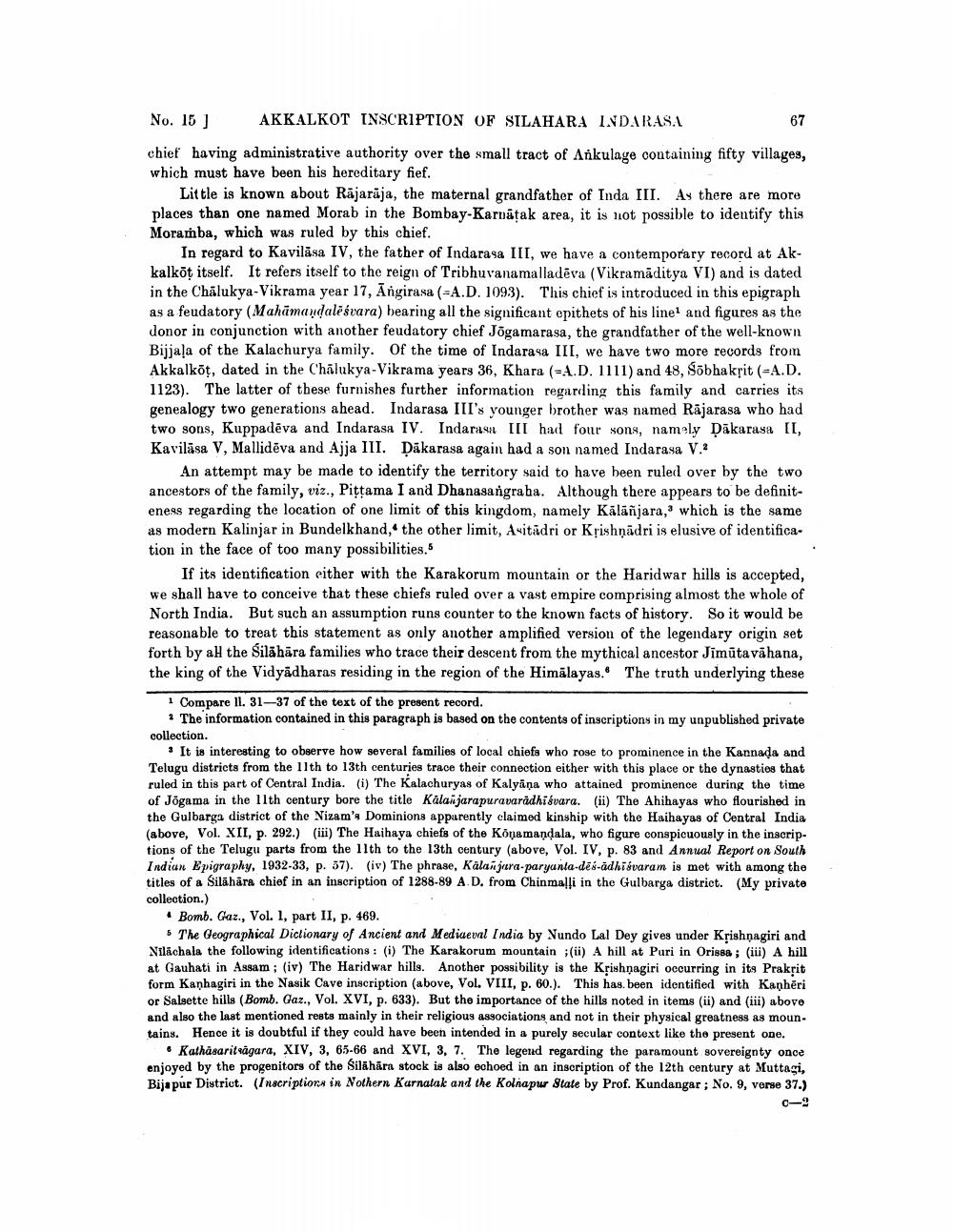________________
No. 151
AKKALKOT INSCRIPTION OF SILAHARA INDARASA
67
chief having administrative authority over the small tract of Arkulage containing fifty villages, which must have been his hereditary fief.
Little is known about Räjarīja, the maternal grandfather of Inda III. Ay there are more places than one named Morab in the Bombay-Karnatak area, it is not possible to identify this Moramba, which was ruled by this chief.
In regard to Kavilāsa IV, the father of Indarasa III, we have a contemporary record at Akkalköt itself. It refers itself to the reign of Tribhuvanamalladeva (Vikramaditya VI) and is dated in the Chalukya-Vikrama year 17, Angirasa (=A.D. 1093). This chief is introduced in this epigraph as a feudatory (Mahamandalesvara) bearing all the significant epithets of his linel and figures as the donor in conjunction with another feudatory chief Jõgamarasa, the grandfather of the well-known Bijjala of the Kalachurya family. Of the time of Indarasa III, we have two more records from Akkalköț, dated in the Chalukya-Vikrama years 36, Khara (-A.D. 1111) and 48, Sõbhaksit (-A.D. 1123). The latter of these furnishes further information regarding this family and carries its genealogy two generations ahead. Indarasa III's younger brother was named Rājarasa who had two sons, Kuppadēva and Indarasa IV. Indarasa III had four sons, namely Dakarasa II, Kavilāsa V, Mallidēva and Ajja III. Dakarasa again had a son named Indarasa V.?
An attempt may be made to identify the territory said to have been ruled over by the two ancestors of the family, viz., Pittama I and Dhanasangraba. Although there appears to be definiteness regarding the location of one limit of this kingdom, namely Kālāñjara," which is the same as modern Kalinjar in Bundelkhand, the other limit, Asitādri or Krishņādri is elusive of identification in the face of too many possibilities.
If its identification either with the Karakorum mountain or the Haridwar hills is accepted, we shall have to conceive that these chiefs ruled over a vast empire comprising almost the whole of North India. But such an assumption runs counter to the known facts of history. So it would be reasonable to treat this statement as only another amplified version of the legendary origin set forth by ah the Silahāra families who trace their descent from the mythical ancestor Jimūtavāhana, the king of the Vidyadharas residing in the region of the Himalayas. The truth underlying these
1 Compare 11. 31-37 of the text of the present record.
* The information contained in this paragraph is based on the contents of inscriptions in my unpublished private collection.
• It is interesting to observe how several families of local chiefs who rose to prominence in the Kannada and Telugu districts from the 11th to 13th centuries trace their connection either with this place or the dynasties that ruled in this part of Central India. (i) The Kalachuryas of Kalyāna who attained prominence during the time of Jógama in the 11th century bore the title Kalanjarapuravaradhisvara. (ii) The Ahihayas who flourished in the Gulbarga district of the Nizam's Dominions apparently claimed kinship with the Haihayas of Central India (above, Vol. XII, p. 292.) (iii) The Haihaya chiefs of the Kōnamandala, who figure conspicuously in the inscriptions of the Telugu parts from the 11th to the 13th century (above, Vol. IV, p. 83 and Annual Report on South Indian Epigraphy, 1932-33, p. 37). (iv) The phrase, Kalanjara-paryanta-des-adhiśvaram is met with among the titles of a Silahara chief in an inscription of 1288-89 A.D. from Chinmalli in the Gulbarga district. (My private collection.)
• Bomb. Gaz., Vol. 1, part II, p. 469.
5 The Geographical Dictionary of Ancient and Mediaeval India by Nundo Lal Dey gives under Krishnagiri and Nilichala the following identifications : (i) The Karakorum mountain ;(ii) A hill at Puri in Orisse ; (iii) A hill at Gauhati in Assam ; (iv) The Haridwar hills. Another possibility is the Kțishnagiri occurring in its Prakrit form Kanhagiri in the Nasik Cave inscription (above, Vol. VIII, p. 60.). This has been identified with Kanheri or Salsette hills (Bomb. Gaz., Vol. XVI, p. 633). But the importance of the hills noted in items (ii) and (iii) above and also the last mentioned rests mainly in their religious associations and not in their physical greatness as moun. tains. Hence it is doubtful if they could have been intended in a purely secular context like the present one.
Kathåsaritsagara, XIV, 3, 65-66 and XVI, 3, 7. The legend regarding the paramount sovereignty once enjoyed by the progenitors of the Silahāra stock is also echoed in an inscription of the 12th century at Muttagi, Bijapur District. (inscriptions in Nothern Karnatak and the Kolhapur State by Prof. Kundangar; No. 9, verse 37.)




